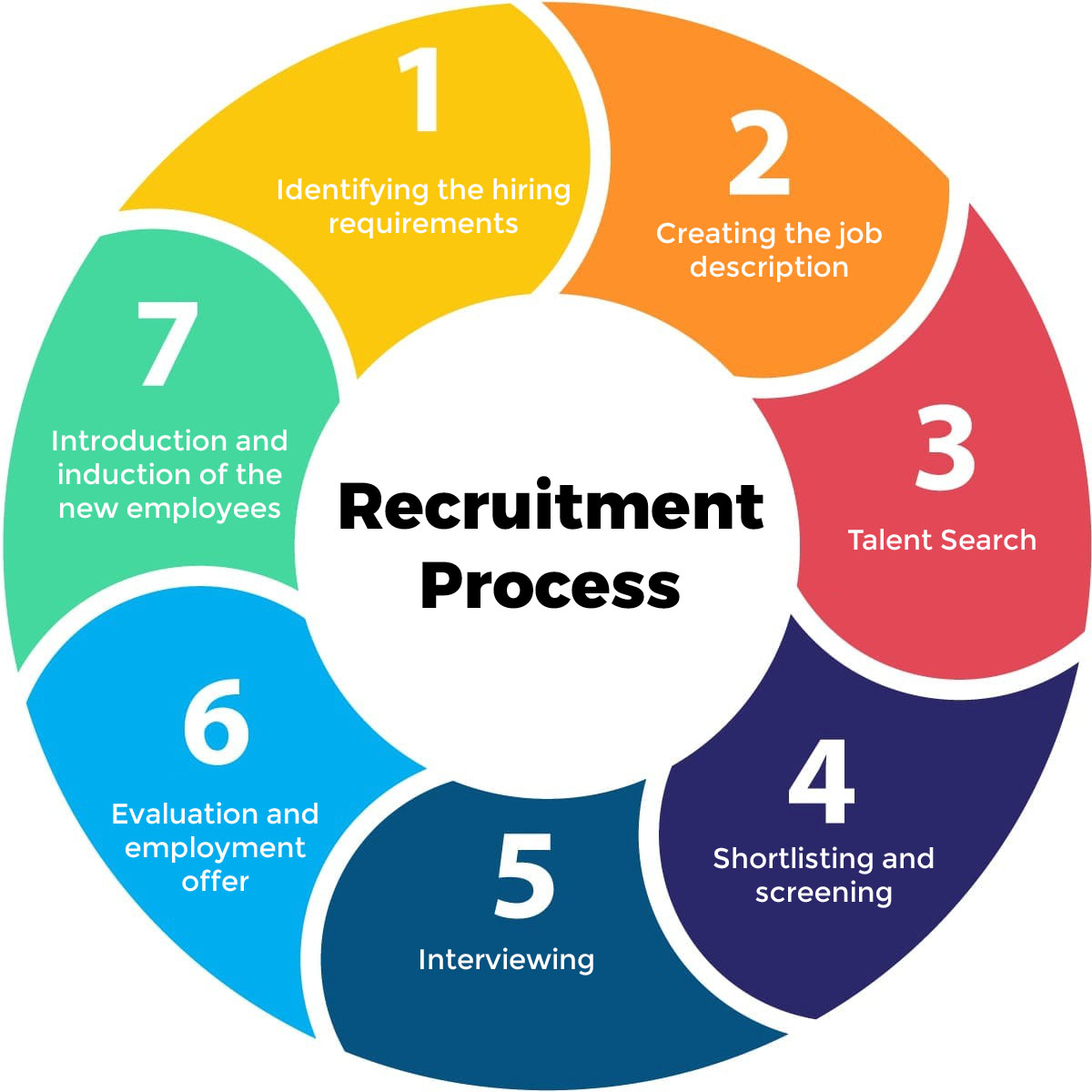
The recruitment process is typically elaborate. It encompasses sourcing candidates to onboarding hired employees and all steps that occur in between.
For the Human Resource department, recruitment is a core function. Characteristically, the recruitment process will initiate by identifying the right sort of candidates for a job. Then, these candidates are attracted, screened, and shortlisted. The interviewing processes can then begin, and after the candidates are selected, they can be hired. Onboarding the employees will be the final step in the recruitment process.
While many organizations choose to conduct the recruitment process in-house, many choose to outsource the process as well. In-house recruitment teams could be small or large. This is frequently proportional to the size of the organization. Similarly, in numerous small organizations, a recruitment manager takes care of the entire recruitment process.

Organizations that manage the recruitment in-house often use implements such as social media channels, job boards, and advertisements for giving out vacancies or contacting prospective candidates directly. Similarly, numerous organizations use recruitment software as well, which yields efficiency and effectiveness for the recruitment process.
What would an ideal recruitment process seem like?
For a recruitment process to be efficient, it should be an organization-specific sourcing model. This will enable hiring managers to figure out the candidates that are the best-fit matches to fit into their organization, at the time when it matters the most. If the approach stays step-by-step, then the right sorts of people join the organization as new resources and the company grows.
It often happens that the recruitment process that one organization follows is different from the one that the other follows. This varies, depending upon the domain of operation, company size, organizational structure, the nature of the work an organization is into, and the existing workflow for recruitment.
A recruitment process should necessarily be robust
To keep a recruitment process foolproof, it should be targeted toward attracting candidates who are well qualified for the job. Similarly, an attempt should be made towards encouraging more and more job seekers to apply, as this will create a big talent pool. The time spent in figuring out the best-suited candidates hence reduces. If the requirements can be met for an organization’s present requirements, they can be met for future requirements as well.
A recruitment process should be rolled out after careful planning and it should be crafted thoughtfully. So, even as the recruiting teams will filter the candidates quicker, they can engage the eligible candidates for driving maximum conversions.
A well-churned-out recruitment process is a direct reflection of a company’s professionalism. This will ensure that the right sorts of candidates are attracted. Similarly, the expenditure of time, money, and efforts on hiring the candidates will also be mitigated.
In general, the seven steps involved in a recruitment process are:
- Identifying the hiring requirements
- Creating the job description
- Talent Search
- Shortlisting and screening
- Interviewing
- Evaluation and employment offer
- Introduction and induction of the new employees
Let us consider each of these steps in further detail.
1. Identifying the hiring requirements
Irrespective of whether there is a newly formed role at your organization or a job profile has just been vacated, you need to be sure about the vacancy that needs to be filled up and the type of candidates that you are on the lookout for. Identifying hiring requirements, in terms of experience, skills, and knowledge required for any job role is always the first step in any recruitment process.
For the same to accomplish, an employer has to figure out the gaps in the current team, and also figure out the outputs received based on the input provided on the behalf of his team. Workload issues need to be addressed. This comes via a regular analysis of team performance. Employers should also attempt to retain their existing employees as and when possible.
It is then equally important to act on hiring requirements well in time. Don’t wait till the last moment, but be prepared in advance.
2. Creating the job description
At this stage, the employer is sure about what he seeks in terms of experience, skills, and knowledge. It is time to create a job description now. This will include the responsibilities and duties for the job for which you are giving out a vacancy.
The best practice in this regard is to always ensure that you create a comprehensive job description. This way, a prospective employee will know if he has the mentioned qualities or not, before applying. They’d have a checklist in place, where they can tick the boxes before applying. So, in your inbox, only the resumes of the right sort of candidates will appear.
A few of the essentials to list in your ideal job description include:
- Title
- Duties & Responsibilities
- Qualification & Skills
- Location
3. Talent Search
If we consider the most important elements associated with the ideal recruitment process, then, beyond identifying the right sort of talent, they are attracting and motivating the talent. If the job listings are internally advertised, you will get some referrals as well.
Beyond this measure, an employer has to leverage social media networks and job recruitment boards to his full advantage. The more people see your job ads, the more of them will apply. This brings ease to hiring the best-suited talent for your job profiles.
When the time comes to look for new talent at your organization, an employer may also choose to promote existing employee(s) to a new role. This will be a motivating experience for an employee. But, an employer has to screen the candidates deemed appropriate for the job. This way, the attrition rates will also reduce within the organization.
4. Shortlisting and screening
The present-day market is talent-driven. Still, 46% of employers face difficulties in attracting top talent. In a majority of cases, identifying the best-suited candidates is the most difficult part associated with recruitment processes.
So, in any organization, screening and shortlisting of candidates should be accurate and efficient. One of the best ways to go about it is to first screen the candidates based on minimum qualifications. Then, one should further shortlist the candidates based on their certifications, technical competencies, domain expertise, and relevant experience.
In the third step, one may shortlist candidates who have both, minimum qualifications and preferred experience. The final step is to flag all concerns and queries that one may have in the resumes, such that they can be clarified while the interview takes place.
An organization may also choose to use an applicant tracking system which brings ease to shortlisting resumes.
5. Interviewing
The candidates who have been shortlisted can now move on to the interviewing phase. After the interviews are through, the candidates may either receive an offer letter or a rejection note. An organization may also choose to schedule multiple interviews for shortlisted candidates. This depends on their unique hiring requirements and their hiring team.
An interview will typically involve a round of telephonic or video interviews, psychometric testing, and face-to-face interview, which is characteristically the final round of interviews.
Telephonic screening is among the most convenient and easy ways to screen candidates and get an overview of their capabilities. One leaves a lasting impression on the employers in this phase.
Psychometric testing is then an equally important phase because an employer comes to know if his employees are going to stay productive over the long run in this phase. The unbiased screening delivers the best fits for any job.
6. Evaluation and employment offer
In the recruitment process, this is the final stage. However, on the employer’s part, it is never easy to be sure that a candidate is going to accept the job offer. Still, if your candidate has taken the time to complete the paperwork and has been waiting through the selection process, he should be taking your offer.
It is a fine idea to check the references before writing down an offer letter. On the offer letter, one should mention the conditions of employment alongside the joining date. All details, including compensation, should be clearly specified.
Onboarding is another process that a recruitment process should involve. The new joinee hence finds it easier to settle down and does not feel awkward. One of the best ways towards onboarding is a general interaction with colleagues, not related to work. Showing around the office and ensuring that essential supplies are handy is also a good idea.
7. Introduction and induction of the new employees
Upon accepting a job offer, an applicant will officially become a part of an organization. Herein, the joining date and time will be shared with the employee.
The next step in line is pre-employment screening, which includes reference and background checks. After the verification completes, the introduction of the employees to the organization can take place. Now, the induction process of the employees can initiate. Herein, employees receive a welcome kit in more cases than not, and the employment contract is also signed.
Conclusion
A professional and well-organized recruitment process highlights diligence and reflects positively on one’s organization. It is a worthy investment for all organizations.
For more Updates
Website – www.shrofile.com
Facebook page – https://www.facebook.com/shrofile/
Twitter page – https://twitter.com/shrofile
Linkedin Page – https://www.linkedin.com/company/shrofile/
YouTube Page – https://www.youtube.com/channel/UChVfJqpTjx1dHJ2xq_dMtAw
Instagram Page – https://www.instagram.com/Shrofile/




